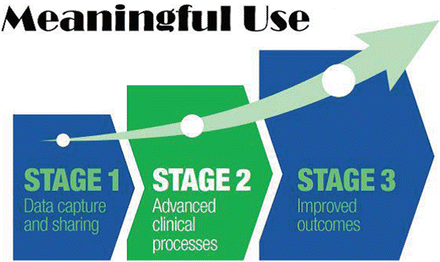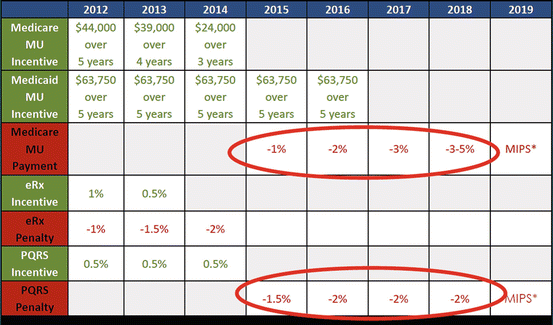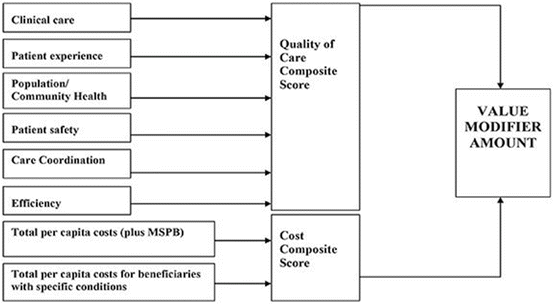The elements of cost can be divided into the cost of direct healthcare services as well as the cost of doing business. This may not necessarily correlate with the critical healthcare cost drivers outlined below that have become omnipresent today. Three important factors should be considered:
- (a)
Health Information technology (HIT) , which is a considerable investment with elusive results, should be considered. Today’s average cost of implementing an Electronic Health Records (EHR) system in a medical practice is approximately $32,000 per physician, through the first 60 days after system launch. One-time hardware costs can range from $25,000 to $60,000 per practice for internet switches, cables, and wireless internet connections, plus approximately $7000 per physician for computers, printers, and other hardware. Software and maintenance costs , which begin at implementation, can range from $12,000 to $19,000 per physician annually [3]. In addition, one must consider the nonfinancial costs, which include the monetary costs of salaries per physician as well as his or her support staff and implementation team. Despite the variability in region, practice size, and vendor, there is considerable cost associated with origination and implementation of any EHR system.
- (b)
Consolidation has been promoted by reform efforts seeking to reduce waste and to reward value instead of volume, but these monopolizing forces are contributing to a rise in costs and leading to lack of competition and extinction of independent medical practices. While independent practices struggle with payer pressures and management challenges, they can deliver a greater quality/value proposition overall. Through mergers and acquisitions, hospitals have grown larger in size and have thereby ensnared more physicians under their control in the last decade. Hospital acquisitions of physician practices tend to lead to higher prices, mostly because of added facility fees by the hospital systems and consolidation of practices, which has not led to either improved quality or reduced costs. It may be argued that the true role of consolidation is to enhance bargaining power with payers and not necessarily to produce integration nor to enhance performance. Advocates of healthcare consolidation, however, may continue to argue that economies of scale, in time, are likely to reduce waste in the system and to ultimately push prices down.
- (c)
Patient consumer movement towards social media and shared decision-making has forced medical practices to engage in newer strategies, which attract new patients and engage their existing clientele. The internet age has helped to ease the dissemination of information, but at a cost to the provider. Ninety percent of adults state that they rely on information gathered from peers through any number of social networks and over seventy percent search online to address health concerns and referral sources. Digital healthcare marketing has seen a significant increase in the past 10 years by reaching consumers through various technologies and targeted campaigns. It has been proven to be highly measurable by allowing providers to focus on targeted populations. However, website development, paid searches, and reputation management all come at a direct cost to a medical practice and although these channels may help to improve traffic and ultimately direct patient flow, it can lead to misappropriation of funds at a cost to patient care. It is important to remember that the best and most cost-effective way to begin marketing efforts is by providing excellent care and service to existing patients. Facilitating potential patient movement, whether it’s simply through word of mouth, marketing assistants, digital marketing, or print advertisements, should not cost a lot of money. Optimizing consumer movement by letting patients know that a practice is willing and able to care for them, and by providing payers an image of quality and professionalism both show how a practice can provide high-quality, cost-effective care.
ICD-10 and Beyond
October 1, 2015 ushered in a new era in the US healthcare system with the 10th revision of the International Statistical Classification of Diseases and Related Health Problems . Four nonphysician groups, or cooperating parties, were all tasked with the development of ICD-10: The Centers for Disease Control and Prevention, Centers for Medicare and Medicaid Services, American Hospital Association, as well as American Health Information Management Association. Along with the national Clinical Modifications (CM ) of ICD, some 68,000 codes are available for use at present day [5]. The financial implications of ICD-10, as well as Meaningful Use (MU) and Physician Quality Reporting Systems (PQRS), can be significant, specifically for those that had remained unprepared and had not begun preparing well before that dreadful day in October.
The impact of ICD-10 spreads through all components of the practice of pain medicine. Billing services, EHR, payers, and documentation are but a few of the components of a medical practice to be affected. Survival in today’s climate is dependent on a rapid and effective management strategy, which involves both practice management systems integration and staff education. CMS reports improvements in clinical care, operational enhancement, and professional advocacy as the goals of ICD-10, but the real question is at what cost to the nation?
Estimated costs over a 15-year period are potentially over $1 trillion [6]. Although this may have led to a significant growth in the Health Information Technology (HIT) and consulting industries, who is to say that the cost justification will ultimately help to achieve the goals set out by CMS over that period of time? Cash flow disruptions to any size medical practice will be significant, as over 50% of providers remain unaware of the cash crunch and over 75% report a lack of preparedness [7].
So, what is the bottom line? Transition and implementation seems to be complicated and time consuming. Furthermore, there does not seem to be any basis on evidence or medical necessity. Even though nonsignificant, improvements have been demonstrated; the system is used in over 200 countries and the US healthcare system must follow the lead if it is to survive [8]. ICD-10 will also impact other required programs. Meaningful Use (MU) is a set of proposed rules, which is designed to improve outcomes and measurement of those outcomes by following a three-stage process (Fig. 73.2).


Fig. 73.2
Meaningful use
Formerly known as the Physician Quality Reporting Initiative (PQRI) , the Physician Quality Reporting System (PQRS) is a voluntary reporting program, which provides a financial incentive for medical and other healthcare professionals who participate in Medicare to submit data on 260 specified quality measures to CMS . The program shifted from voluntary to mandatory utilization in 2015, characterized by the assessment of penalties for a failure to participate as outlined in the table.
Current Financial Implications
The Value Based Modifier (VBM) program , which is based in part on participation (Fig. 73.3), assesses both quality of care furnished and the cost of that care under the Medicare Physician Fee Schedule. CMS began phase-in of the VBM in 2015, and is anticipated to be completed in 2017, when the VBM will be applied to solo practitioners and groups of two or more providers. The premise involves rating providers based on the PQRS measures. Providers undergo mandatory quality tiering to determine if performance is statistically better, the same, or worse than the national mean.


Fig. 73.3
Financial implications
Quality Tiering Protocol [ 9 ]
Beginning in 2019, Medicare will begin to issue payments based on the combination of MU, PQRS, and VBM (Fig. 73.4). This system has been designated as the Merit-Based Incentive Payment System (MIPS) . A composite performance score of 1–100 will be assessed, which is based on performance in quality, resource utilization, clinical practice-improvement activities, and meaningful use of EHR. Providers, whose composite performance scores are above the set threshold, will receive positive payment adjustments. These adjustments can be up to 4% in 2019 and may grow over time to a maximum of 9% in 2022 and beyond [10]. A special additional “Incentive Payment,” funded with $500 million per year, is applied for the top 75% of physicians above the performance threshold. The interpretation of pain management specialty outcomes measures is poorly understood, at best. Most carriers fail to understand measurable pain medicine outcomes, such as reduction of emergency room visits, surgery, missed work days, opioid burden, and increases in function, quality of life, and mood. Education will be the key to both the understanding and the legitimate assessment of such measures, as it relates to our specialty.


Fig. 73.4
Quality/tiering protocol
Accountable Care Organizations
An accountable care organization (ACO) is a type of payment and delivery reform model that ties reimbursements to providers, quality metrics, and reductions in cost of care for an assigned population of patients. An ACO is formed by groups of doctors, hospitals, and other healthcare providers, who come together voluntarily to provide coordinated quality care to their patients; it is accountable to patients and payers for the quality, appropriateness, and efficiency of the healthcare provided. The model is designed to be flexible with three core principles that have been defined for all ACOs: ACOs are provider-led organizations, collectively accountable for quality and costs across the full spectrum of care; ACO payments are linked to quality improvement metrics that also reduce overall costs; ACOs have reliable performance measurements to support improvement and savings achieved through improvements in care. ACOs can be subdivided into three types: (a) Medicare Shared Savings Program, which facilitates Medicare fee-for-service program providers becoming an ACO; (b) Advance Payment ACO Model, which is a supplementary incentive program for selected participants in the Shared Savings Program; (c) Pioneer ACO Model that was originally designed for early adopters of coordinated care [11].
These care models have been adopted by Medicare, state Medicaid plans, and commercial health insurers and their initiatives have led to an increase in the number of ACOs from fewer than 100, to well over 700 in the past 5 years. ACOs now exist in all 50 states and provide care for more than 23 million people [12]. The dynamic change in our healthcare system, whereby providers will increasingly be paid to effectively manage the health of populations rather than based on the volume of services they provide, has led to a change in the payment model. The financial risk from payers has now shifted toward providers and in doing so, providers are strongly incentivized to change how they are delivering care, with the goal of decreasing spending, while improving quality measures and patient satisfaction.
Interventional pain management and reimbursement reform is a murky area as it pertains to ACOs. The specialty of pain management provides cost-effective care using minimally invasive procedures instead of major surgery or excessive and expensive drug prescriptions. Minimizing drug prescriptions reduces unnecessary admissions and the complications of accidental deaths and prescription drug abuse. Interventional pain management specialists, with direct communication between primary care providers and surgical specialists, also improve the continuum of care, which is one of the principal aspects of healthcare reform and foci of ACOs. This structure includes bundled payments, which compensate the hospital and the ACOs a pre-decided amount for a specific episode of care. Bundled payments will supposedly incentivize physicians to work together to reduce cost, but do not necessarily incentivize doctors to work together or lead to higher quality care, nor do they take into account the treatment of chronic conditions. There are some who may consider this methodology as an oversimplification of physicians’ motives, reducing them to mere responders to economic incentives. In time, with societal and specialty organization support and lobbying, there will hopefully be a realization that interventional pain specialists care about providing high-quality care, while understanding the importance of cost-effectiveness. This will be a critical component of specialty reform and survival of interventional pain management under the ever-growing proliferation of ACOs.
Stay updated, free articles. Join our Telegram channel

Full access? Get Clinical Tree





